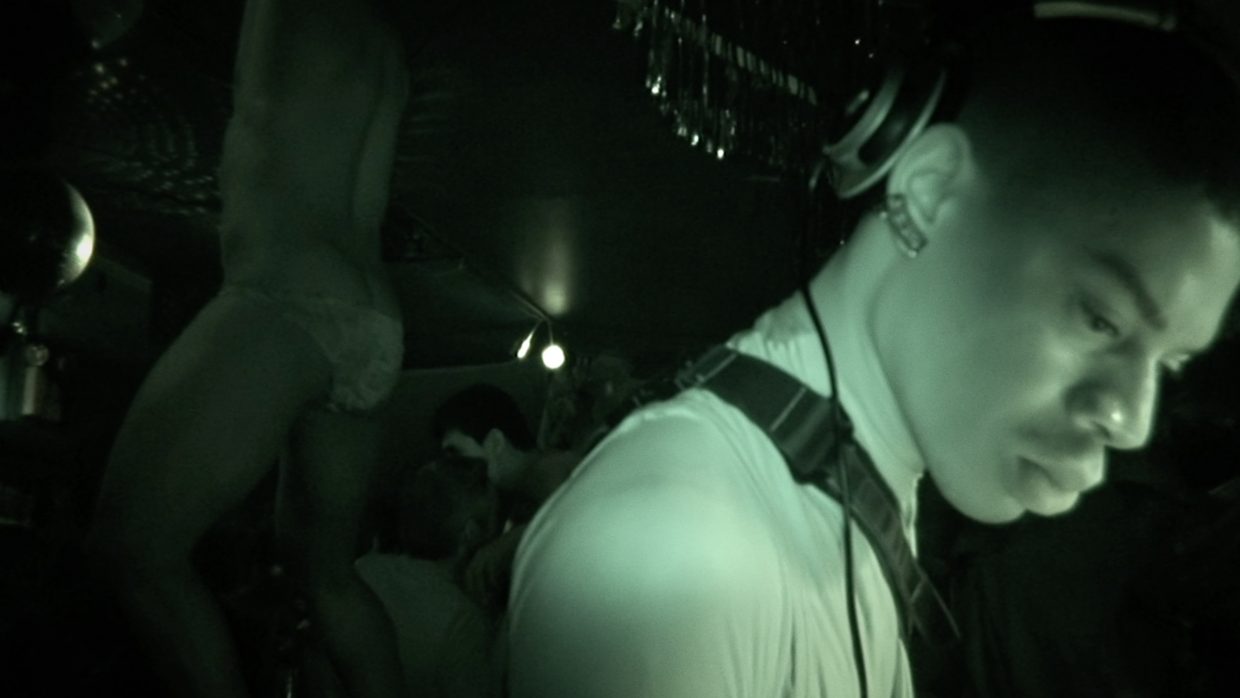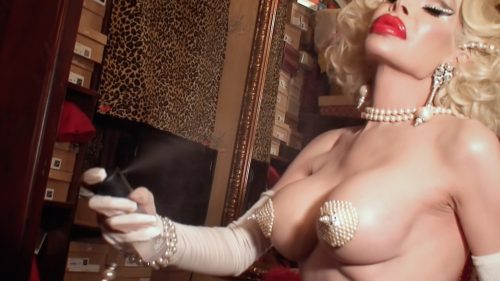 Back to selection
Back to selection
“A Vindication of the Primal Nature of Creativity, Spontaneity, and the Uniqueness of Each Human Being”: Gustavo Sánchez on I Hate New York
 I Hate New York
I Hate New York For those of us who spent most post-midnight hours of the Giuliani years on the smoke-choked dance floors of places like Limelight and The Pyramid Club, I Hate New York, the debut feature of Barcelona-born journalist Gustavo Sánchez, is a walk down an age of innocence memory lane. A pre-9/11 time when nightclub royalty such as Amanda Lepore and Sophia Lamar were as ubiquitous as the flyers in the St. Mark’s record stores that showcased their names.
For those not steeped in trans-fabulous NYC lore, the aforementioned Lepore is best known as the longtime (Jessica Rabbit-esque) muse of David LaChapelle, while (Lepore’s former friend) Lamar is a no-nonsense refugee from Castro’s Cuba who began her reinvention as an avant-garde artist during NYC’s punk heyday. For over a decade (2007-2017), Sánchez tagged along with each on their various East Village excursions, as well as followed trans and AIDS activist Chloe Dzubilo, lead singer of the pioneering punk band Transisters, and activist/DJ/rapper T De Long. The resulting film, a clear-eyed downtown history lesson, is distilled from hundreds of hours of interviews, fly-on-the-wall observations, and VHS-style footage. From contemporary Tompkins Square Park to flash-from-the-past SqueezeBox, I Hate New York is also, thankfully, more nostalgia-free love letter than cinematic poison pen.
On the day of the film’s September 1st digital release, Filmmaker caught up with Sánchez, who in grade school became the youngest radio host in Spain, to find out why and how he decided to document the dogged survivors of a long corporate-coopted underground scene.

Filmmaker: So how did this decade-long project begin? Was the focus always going to be on these four characters, or did you film with other NYC nightlife notables?
Sánchez: The project began in 2007 with the intention of documenting the essence of New York’s underground scene after the impact of 9/11 — a critical moment in which the city was seeing much of the subculture that had characterized it for decades disappearing. I wanted to portray, almost in a journalistic way, the spirit of a time that was rapidly fading.
For several years I collected hundreds of hours of footage of the opinions, experiences and confessions of musicians, filmmakers, writers, designers, strippers, nightlife promoters, and countless artists and anonymous characters.
From all of these voices, a few stood out due to their particular strength and attitude. In a very special way, the four protagonists of this story ended up taking over the film. I Hate New York portrays my admiration for their struggle, and their determination to be, live, and express themselves freely.
Filmmaker: You’re from Barcelona and didn’t actually experience the NYC scene that brought these nightlife stars into the spotlight. So how did your outsider status affect obtaining intimate access to such image-conscious characters? (Though I’m guessing that sharing a native language with the Cuba-born Sophia Lamar might have helped gain her trust.)
Sánchez: I never felt like an outsider in New York City. I arrived with a humble and respectful attitude, and the city and its people welcomed and accompanied me at all times.
I was able to ask, observe, and listen. I carried my little camera in my coat pocket permanently and filmed 24/7. I searched for truth, to capture the reality, the “decisive moment.” And after many years and hundreds of hours of filming, sometimes I succeeded!
I never wanted to be the protagonist of the documentary. I discarded the voiceover from the very beginning of the project. I never wanted to appear in the shoots. (I can only be heard once asking a question.) Later, in the editing room, I expressly dedicated myself to eliminating any overacting or attempted dramatizations from the protagonists — in a continuation of my search for capturing only truths.
Another important thing to note is that this documentary was made in the absence of many technical resources — for example, proper lighting, sound or stabilization. Also economic resources, as I never had a production company to finance the project. The lack of these conventions permitted me the freedom, and also the naturalness, to eliminate barriers between myself and the protagonists. By reducing the film structure to a minimum, I was able to gain agility and time to capture reality.
Filmmaker: I read in your bio that you grew up in Spain in the ’80s and ’90s, and were later influenced cinematically by the work of John Cameron Mitchell and Jonathan Caouette. But considering that the dictatorship only fell in 1975, how did the post-Franco environment that you were raised in (and that brought us Almodóvar) influence your decision to pursue a career in journalism, and later filmmaking?
Sánchez: Seen now from a distance, Spain of the ’80s and ’90s was a space of creative freedom that we now almost envy. I grew up in a country that had to reinvent itself in a very short period of time, pushed by necessity but also by a unique and unbridled energy that was not yet regulated by trends or globalization.
My restlessness and curiosity are the result of that particular moment in Spain where everything seemed possible. I wanted to trace this same spirit back to New York, to those struggles for freedom of thought and expression that generations before me had longed for.
During my adolescence, I was imbued by my older brother with all kinds of independent cinema, both American and global. It was in the early 2000s that I was amazed by the rawness of Jonathan Caouette’s documentary Tarnation, which somehow inspired me to portray people from a position of utmost intimacy. On the other hand, John Cameron Mitchell’s Shortbus connected me to a generation of marginalized New York artists struggling to express themselves freely.
I Hate New York is an ode to freedom, an ode of love to people who do not set limits for themselves, who transgress. But it is also a necessary state of mind — one that does not conform to prevailing limitations and is also a vindication of the primal nature of creativity, spontaneity, and the uniqueness of each human being.
With this film I wanted to strike a strong blow. It’s a declaration of “That’s enough!” I would like the stories of these four artists to reach all those people with power and prejudices that limit, silence, repress and humiliate those weaker than them.
Filmmaker: You’ve worked in a variety of mediums, even began hosting a radio program at the age of seven. So how did your journalistic skills apply to the making of this debut feature? Did your track record ultimately help with the financing at all?
Sánchez: I Hate New York is my first film and, without a doubt, it’s the result of patient work and constant and determined learning. Yes, as a child and teenager I was the youngest radio program host in Spain. Already at that time I was interviewing dozens of stars of music, film and culture. I then studied Languages, Literature and Audiovisual Communication at university — a degree that allowed me to combine my journalistic vocation with my passion for film. I think that during all of these years a documentary filmmaker was being forged without my knowing it.
Due to my journalistic vocation, what matters most to me are stories — true stories — without filters, without impostors. To capture seconds of reality that over the years can be analyzed as time capsules, waiting to be discovered and studied by future generations.
This documentary has always been a self-financed project, although it has enjoyed the generosity and unconditional support of hundreds of people around the world. I have never resorted to public or private funding, or crowdfunding platforms. I wanted to experiment at all costs with my own means, and I did so with the few resources I had at my disposal.
The truth is, I didn’t have much interest in being part of the huge industrial network that is involved in producing a film. I think this would have detracted from its spontaneity. Rather I preferred to build a different story. I felt an enormous excitement in going against the tide in a fully conscious way – seeking to escape the pressures, creative impositions and deadlines of the industry.
In the last year, when the film was practically edited, I showed the final cut to the brothers Carlos and J.A. Bayona. They were both amazed with the love and stories of struggle told by I Hate New York. They, together with their entire team, didn’t hesitate to get involved in the executive production of the film.
Filmmaker: The archival images that you use have the feel of a home movie stash. Where did you find all this footage, and how much did you end up working with?
Sánchez: The archival images are home productions of VHS, Betacam or Super 8 that date from the late ’80s, ’90s and early 2000s and [which] connect present time with the origin of the real stories portrayed. In general these are simple audiovisual pieces but, in my opinion, they record magical moments of the New York underground of the last three decades.
In order to reconstruct the career of the artist and activist Chloe Dzubilo, I was fortunate enough to encounter the generosity of filmmakers Katrina del Mar and Alice O’Malley. For Amanda Lepore I counted on essential downtown photographers such as Jacob Fuglsang Mikkelsen, Caroline Torem Craig, and Miguel Villalobos. All of them gave me access to their video and photographic archives, with the ultimate goal of being able to spread the images and show the world the long-silenced life and work of the protagonists. To my surprise, the vast majority of the pieces that appear fit together like a puzzle.
The process of collecting the rights was the result of very intense documentation work. The montages were infinite, but when we found a transcendental video we fought to get it. It wasn’t always possible to include everything we would have liked, though I think the result is the best version possible, much better than we could have ever imagined.
